This post contains affiliate links for products we love. Italian Kitchen Confessions earns a small commission on these links at no cost to you.
This Ravioli recipe with spinach and ricotta is one of the most authentic Italian pasta recipe. Made entirely from scratch, this traditional Italian dish features soft egg pasta filled with creamy ricotta cheese, sautéed spinach, and a touch of nutmeg. Whether you’re planning an elegant dinner or looking to expand your homemade pasta recipe collection, this step-by-step guide will help you master how to make ravioli from scratch—with tips on freezing, serving, and wine pairing.
Spinach ricotta ravioli taste creamy, mild, and comforting—with a fresh, slightly earthy twist from the spinach. Every bite will reveal the perfect symphony of spring ingredients and most importantly will show how dear ones your love, the secret ingredients!
I have to confess that I have a passion for making homemade pasta and this recipe was missing, so I hope you will enjoy delving into the art of making spinach ricotta ravioli from scratch.
WHY YOU WILL LOVE THIS RICOTTA AND SPINACH RAVIOLI RECIPE
This homemade ravioli with ricotta and spinach is a celebration of fresh ingredients and Italian tradition. Here’s why it deserves a spot in your dinner rotation:
-This is authentic Italian pasta recipes, that you can make in spring when spinach are fresh but also in the winter, using frozen spinach.
-This cheese spinach ravioli is made with simple, wholesome ingredients: No preservatives, just flour, eggs, cheese, and spinach.
– This handmade ravioli recipe is very versatile: Easily adaptable with different fillings, sauces, or even gluten-free pasta dough.
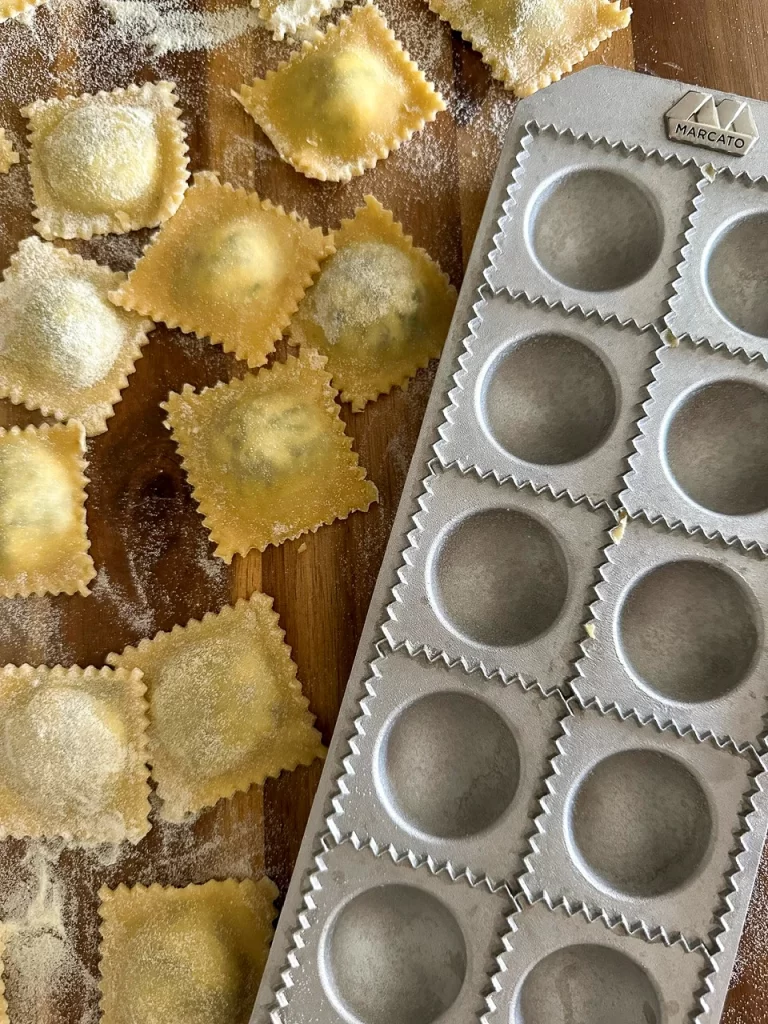

WHAT IS RAVIOLI?
Ravioli are square or round pockets of pasta dough filled with savory ingredients. The ingredients for fillings can vary from cheese, meat, vegetables, or a combination of any of these This Italian ravioli recipe focuses on one of the most beloved versions: ricotta and spinach ravioli, known for its creamy, mildly tangy filling and versatile flavor.
Originating in northern Italy, ravioli have been enjoyed for centuries and remain a cornerstone of Italian Sunday dinner recipes. When made at home, ravioli bring a sense of rustic charm, authenticity, and comfort straight to your kitchen.
Needless to say that every region in Italy has its own version of ravioli, characterized by different shapes and filling. So you can find agnolotti (Piemonte) cappelletti and tortellini (Emilia-Romagna), tortelli (Lombardy) mezzelune (Trentino), culurgiones (Sardinia) or casunzei (Northern Veneto), Pansoti (Liguria).
HOMEMADE SPINACH RICOTTA RAVIOLI INGREDIENTS
For this homemade spinach and ricotta ravioli you will need the ingredients for:
Egg Pasta dough Ingredients:
00 Italian flour: this is the finest Italian flour used to make fresh egg pasta. As usual I recommend to use a digital scale to weigh your flour as cups is not always the best way to measure flour to obtain a perfect pasta dough. I recommend Antimo Caputo 00 flour.
Durum wheat flour: you will need semolina to add to the dough. Semolina will give your pasta a full sensation of roundness into your palate. In addition you can also sprinkle it over your work surface.
Eggs: count 1 egg for every 100 gr. If you want a richer dough, add more egg yolks. If you want a more hydrated dough use the egg whites of one more egg. Make sure you remove the eggs from the refrigerator at least 1 hour before you start making the pasta dough.The eggs at room temperature disperse better into the flour. Ideally you should have 57grams of egg for every 100 gr of flour.
Homemade Ricotta Ravioli Recipe filling ingredients
Spinach: Earthy and green, but mellow—adds depth without bitterness. if you can, prefer fresh spinach. You will need to boil them 2-3 minutes in boiling water. Strain them with a spider, and place them in water and ice for them to keep the green color and get cold. Once cold, squeeze them very well and remove all the water. Chop them finely. If you use frozen, unthaw them and remove all the water. Chop them.
Egg: 1 egg beaten will work as binding ingredients.
Parmesan: It adds a umami flavor and give a kick to the entire filling. Grate you own!
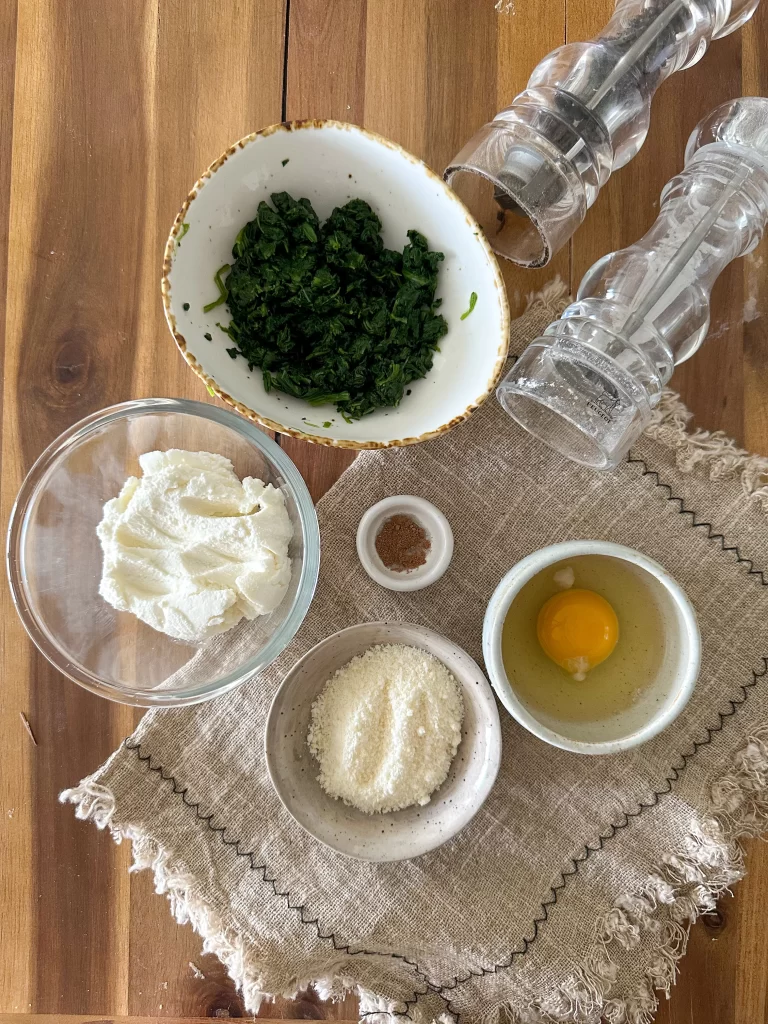
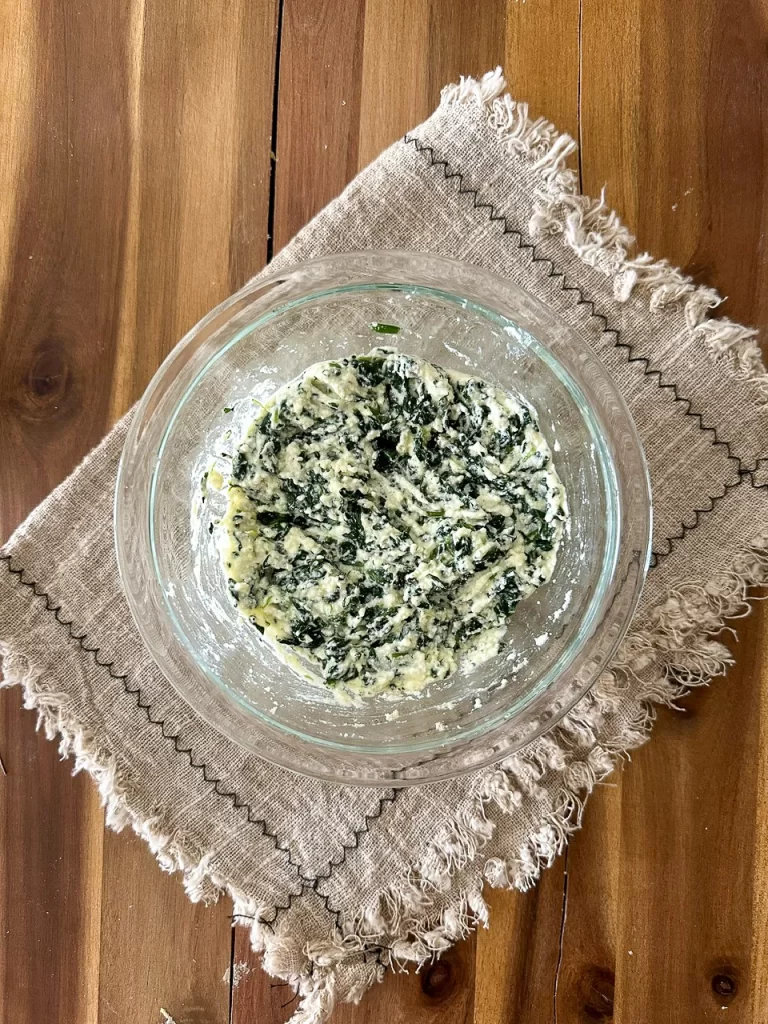
Ricotta: Soft, milky, and slightly sweet—like a mild, fluffy cheese. Use whole ricotta, it will add creaminess and that delicate taste that makes this ravioli recipe so unique.
Freshly Grated Nutmeg: a pinch of nutmeg will add sweetness to the ricotta and pairs well with the spinach.
Salt and Pepper: to taste. Possibly marine salt and freshly ground black pepper.
Simple Sauce for Spinach Ricotta Ravioli
Butter: unsalted, do not skimp on it!
Sage: it is paring greatly and add warmth and a delicate herbaceous taste to the dish.
Parmesan: add a bit on top, use a microplane to have it like flurry, so that will be delicate and not covering the taste of the ravioli.
EQUIPMENT YOU WILL NEED TO MAKE HOMEMADE RAVIOLI
Pasta machine – I use a marcato Atlas pasta machine. You can also find a more affordable model here. I recommed though marcato as with the time you can buy different attachments to vary your pasta shaping.
Wooden board – Key for any pasta making, you can use your own wooden board as a good start. If you fall in love with pasta making I recommend to upgrade to a bigger one, like this. A wooden board will precent your counter top to get ruined by cutting the dough and then the flattened noodle, and it will also be easier to clean up.
A rolling pin is always good to have especially to flatten the dough before using the pasta machine.
You will need also a bench scraper will help you to bring the dough together once you have cracked the eggs.
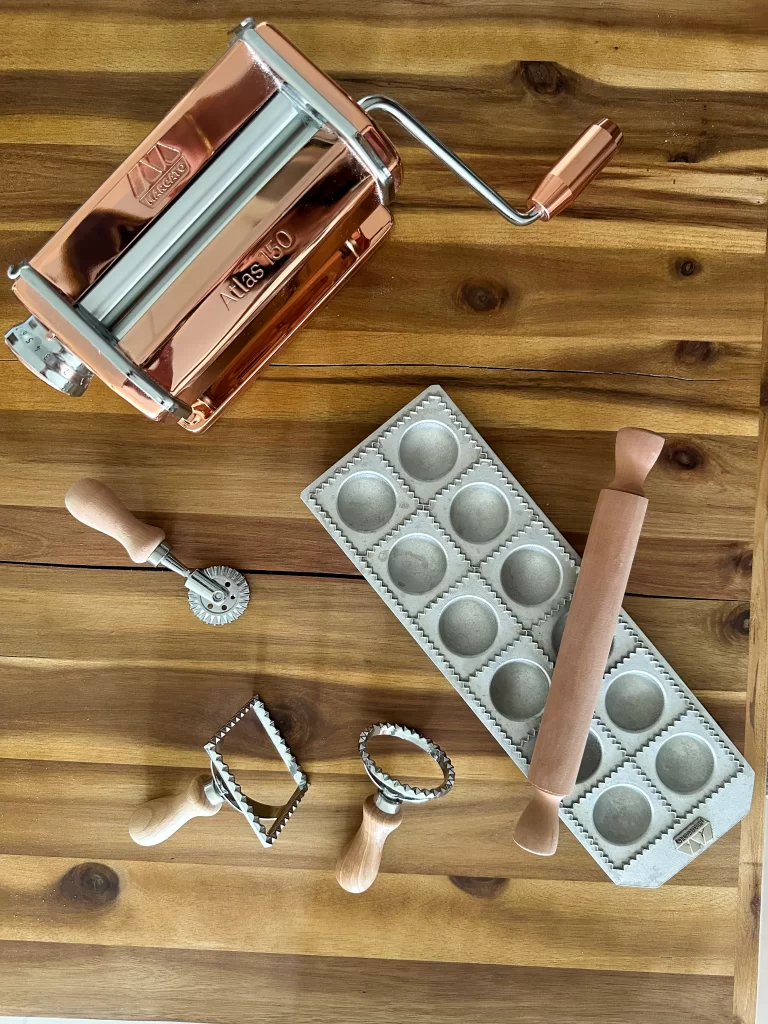
If you really get into the habits of making your homemade pasta, I also recommend a pasta cutter A knife or pizza wheel will also do the trick.
Finally I suggest investing in a good quality digital food scale: it will provide you with the precise measure for the ingredients, ensuring the correct ratio of flour to eggs.
For the ravioli, a knife or pasta cutter can be good, but I recommend some ravioli stamps, usually they come in different sizes and shapes.
The best and most useful tool when malking ravioli, is a ravioli mold. I have a Marcato, as I make this quite often, but if it is your first time and you prefer something more affordable, this version is equally good.
HOW TO MAKE RAVIOLI FROM SCRATCH
Step 1: Make Fresh Pasta dough for Ravioli
The following are the instructions to make homemade pasta dough by hand. You can also read my guide how to make homemade pasta dough, for more tips and details.
a) Form a Well: On a clean work surface, pile the flour into a mound and create a wheel l in the center. Crack the eggs into the well and add a pinch of salt.
b) Mix: Whisk the eggs with a fork. Incorporate the flour from the edges of the wheel and incorporate it as you whisk. Feeling the dough is important to understand the right level of elasticity that will result in a much better quality of fresh pasta.


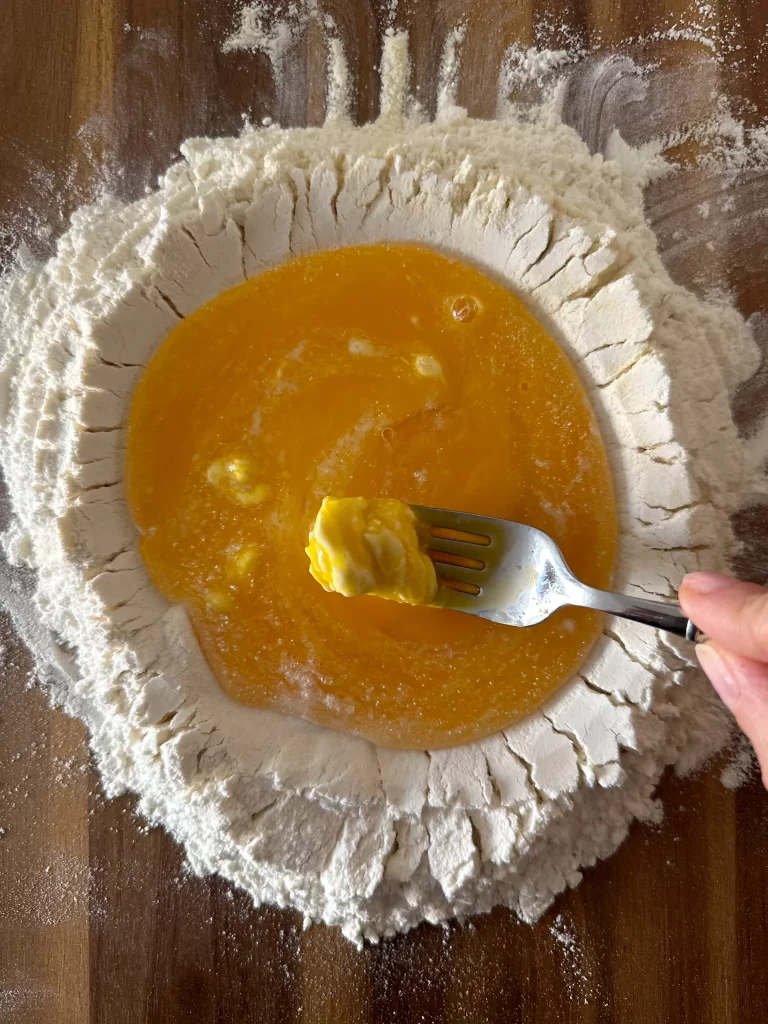
c) Knead: Use a bench scraper with cutting movements until all flour has been incorporated. Gather the dough together with your hands and start kneading. Knead firmly for about 8–10 minutes, until the dough becomes smooth and elastic.
d) Rest: Cover the dough in a plastic wrap, place it in the refrigerator for 30 minutes. Alternatively you can cover it with a tea towel or an upside down bowl and live it at room temperature, away from any source of heat or cold air.

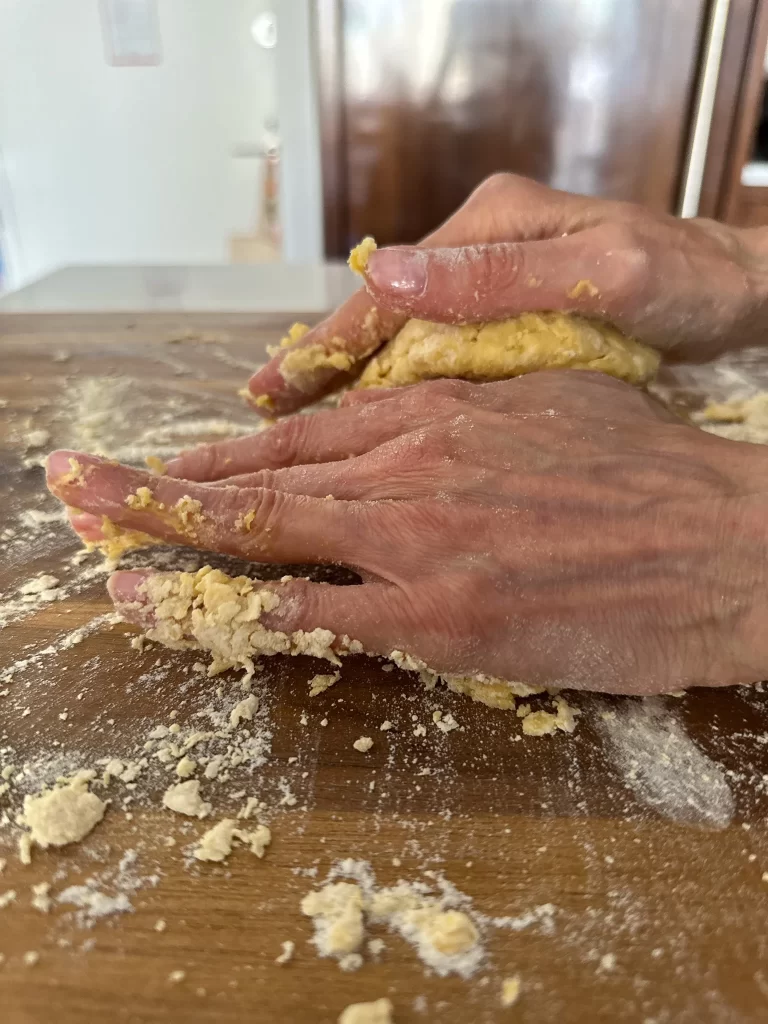

Step 2: Make the Ricotta and Spinach Filling
1. You will need to boil them 2-3 minutes in boiling water. Strain them with a spider, and place them in water and ice for them to keep the green color and get cold. Once cold, squeeze them very well and remove all the water.
2. Chop finely and mix with ricotta, Parmigiano, egg yolk, nutmeg, salt, and pepper.
3. Stir until smooth and refrigerate while you roll out the dough.
Step 3: Roll the dough into fresh pasta sheets
a) Divide the dough into 4 parts: After you rested the dough for 30 minutes, divide it into 4 parts and cover them with a linen towel to prevent your dough to dry. With a rolling pin well-floured, start by rolling each piece from the center to the outer part on a floured countertop. When it reaches around 1/8 inch of thickness, then you are ready to use a pasta machine.
b) Use a pasta machine: and pass the dough through its rollers. I use the thickness of 0 at first, then I pass it to more times into thinner thickness. I usually proceed from 0 to 2, then 3, then 4 and then 6. By doing this, you will obtain the lasagna, which is a wide stripe of pasta.
TIP:You will know it is the right thickness when you will see clearly the shadow of your hands if you will elevate your sheet against the window. In general for long shape should be thinner, you can set the rolling pin up to 8. For filled pasta, I would not go more than 8. For shorter pasta I suggest stopping at 5, as a slight thicker oasta will hold better the shapes.
b) Cut the sheets: At this point you need to cut your sheets into the desired shapes of pasta. Let’s learn how to make ravioli shape!


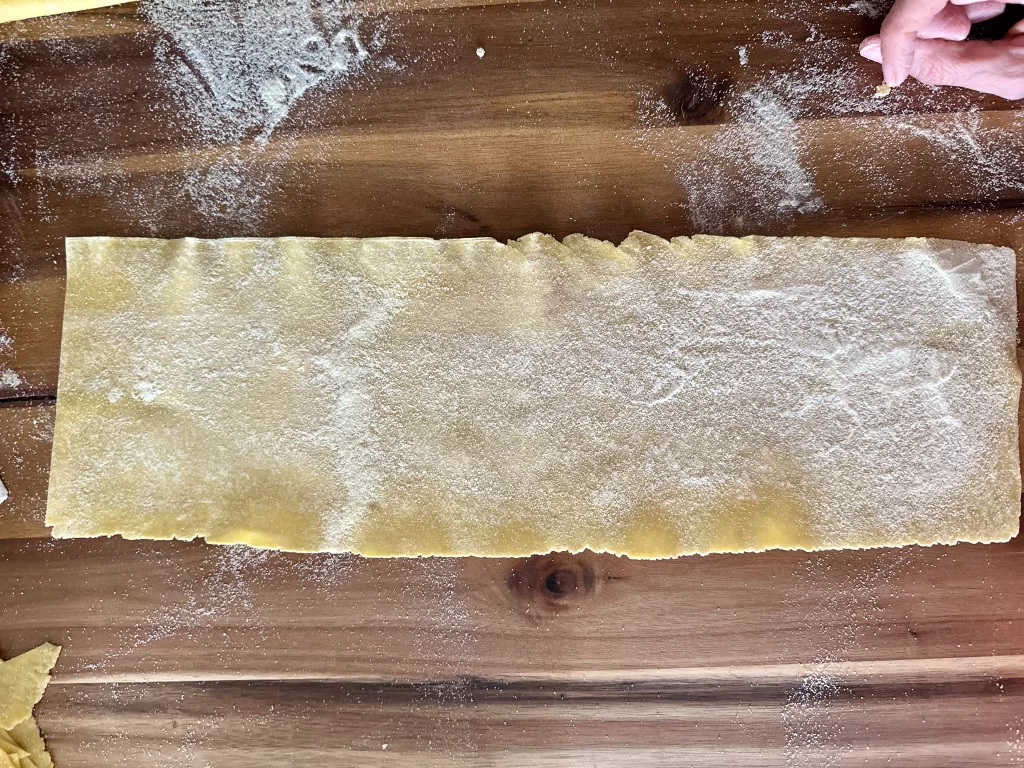
Step 4: Shape and Fill the Ravioli
There are 3 different way to make handmade ravioli: with a ravioli mold, using a ravioli stamp or using a pasta wheel.
Let’s review them one by one.
Using Ravioli Mold: quicker, as you can make more ravioli in one go. This will be easy ricotta and spinach ravioli shaping method for beginners.
1. Lightly flour your ravioli mold. Shake the excess of flour. Place one sheet of pasta on top of the ravioli mold, ensuring to fill each hole.
2. With a pastry bag, add a mounds of filling in each hole.
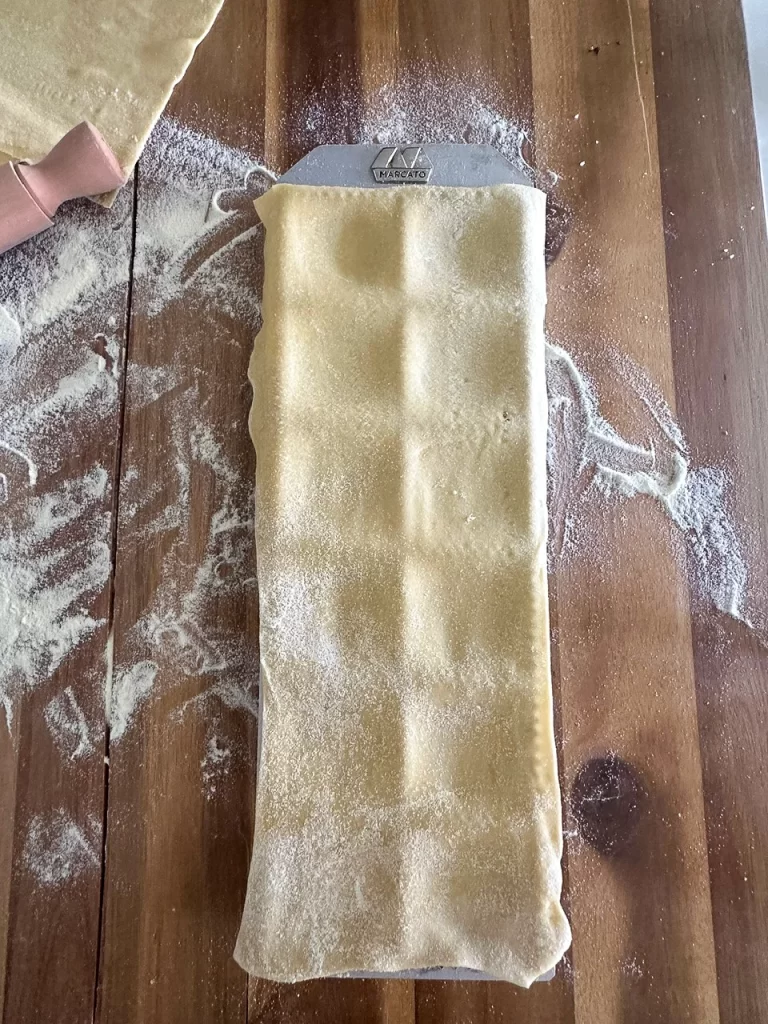
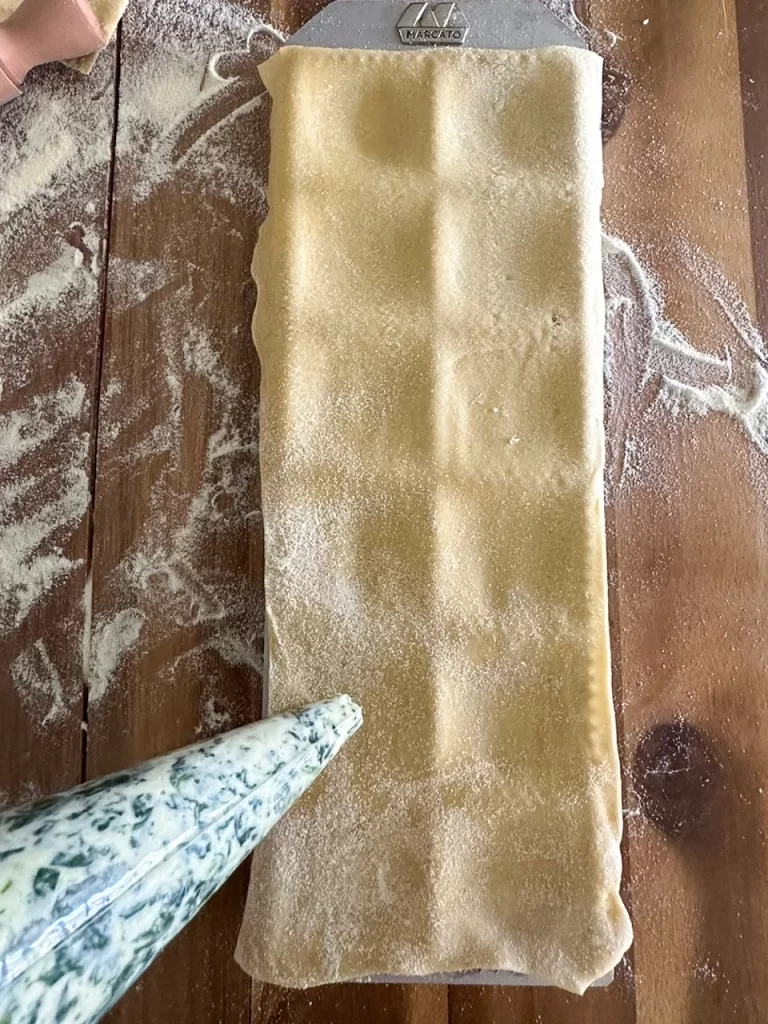
3. Place on top another sheet of pasta to close the ravioli. Using a rolling pin, press and roll to cut the excess of pasta.
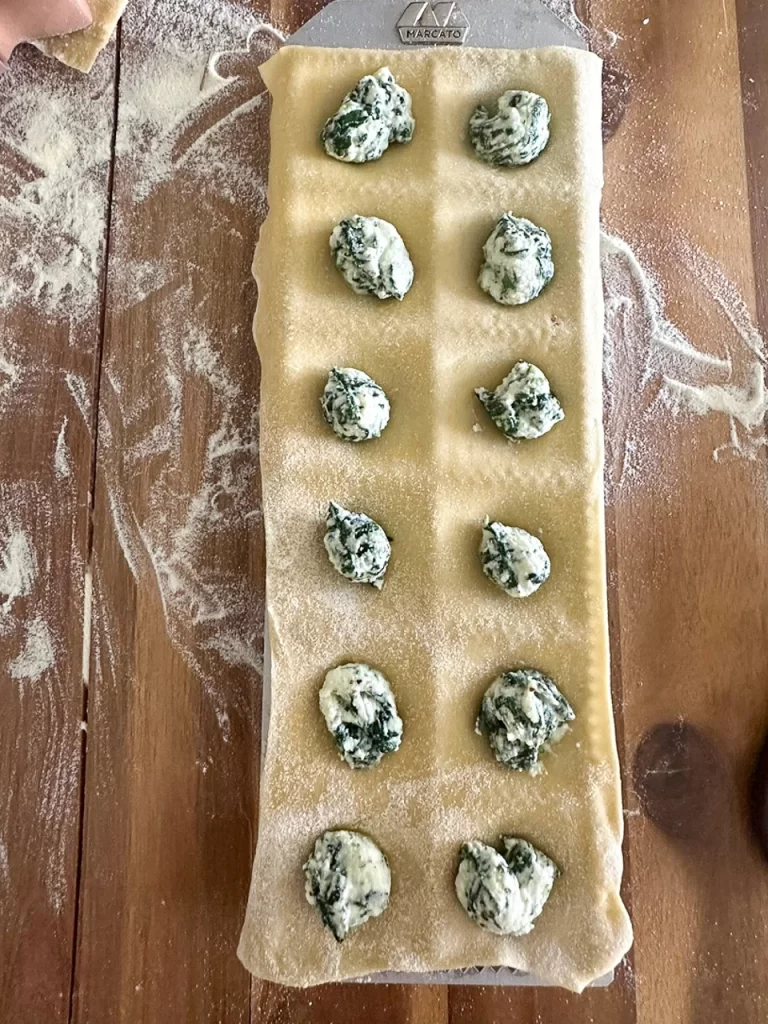
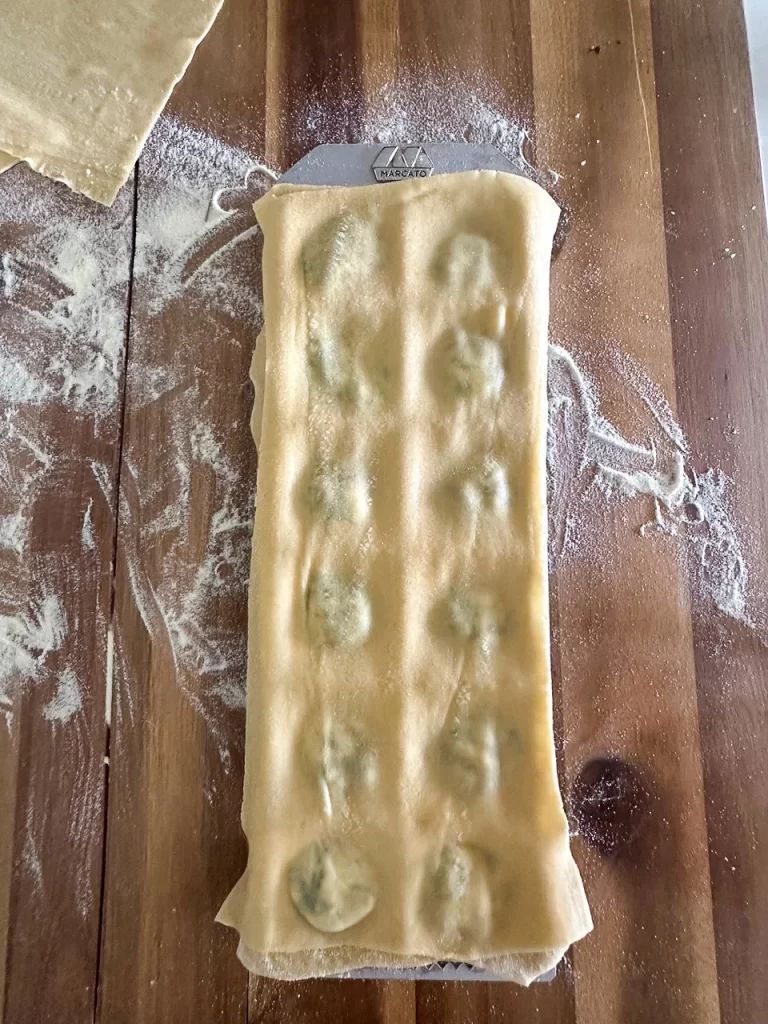
4, Flip over your ravioli mold, and you have your ravioli.
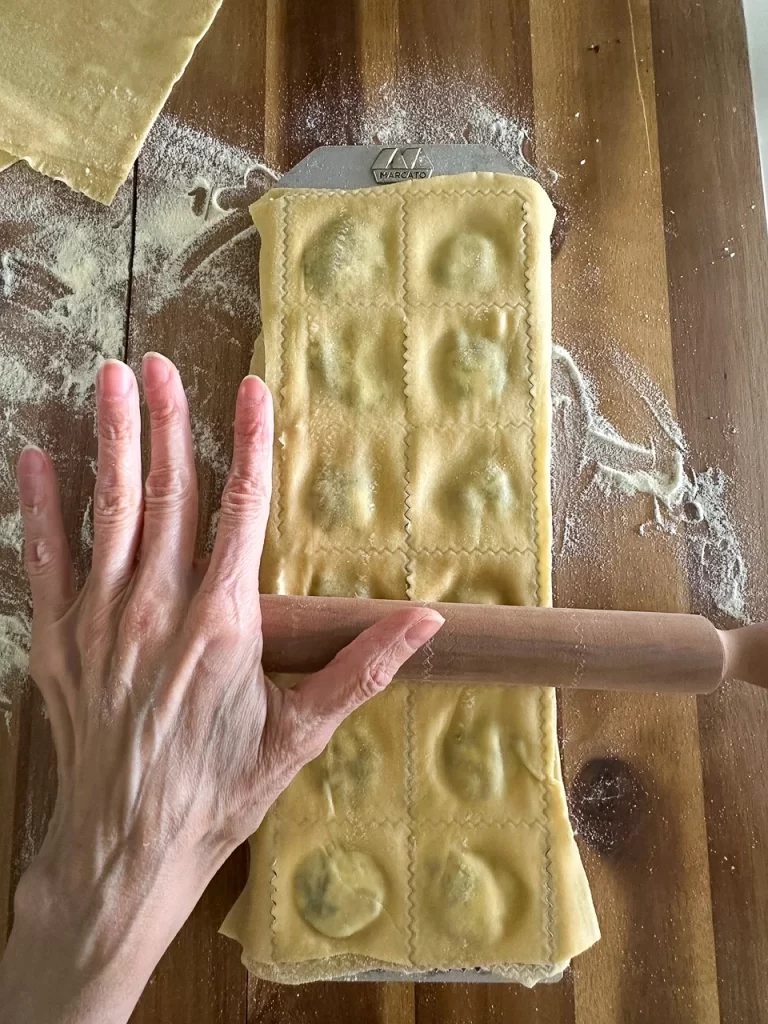
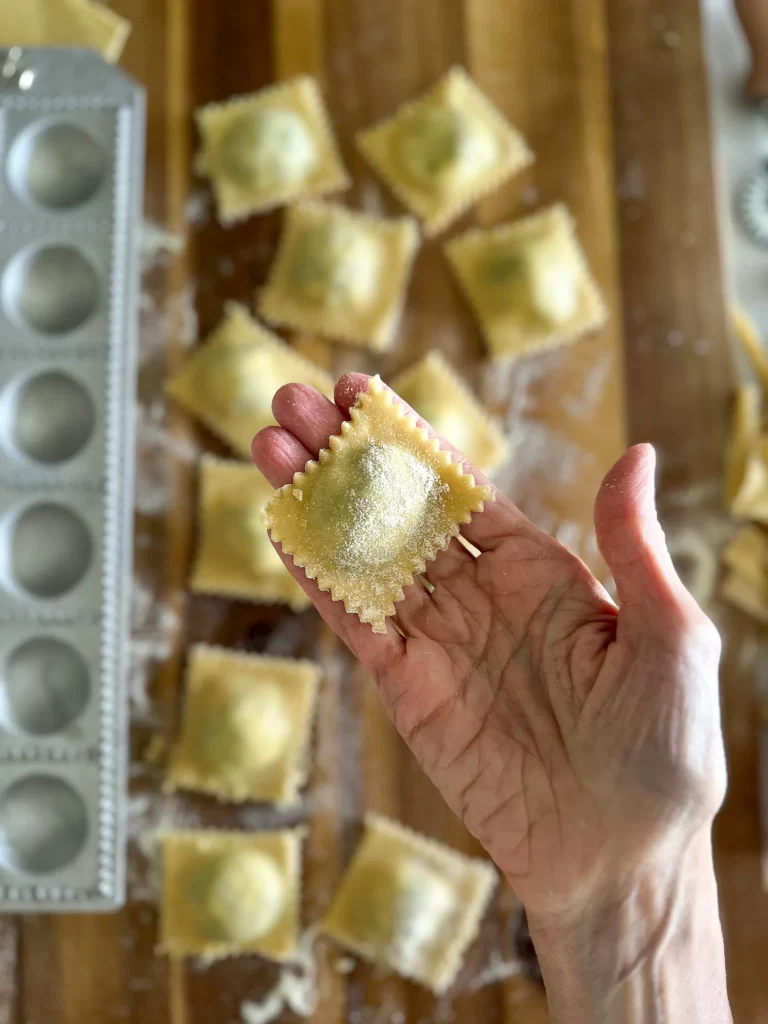
Using pasta cutter ( process is similar using ravioli cutters or stamps)
Ravioli stamp will give you the same identical shape, and it is easy, just you will have to do it one by one. The Pasta wheel cutter, will require instead more precision.
1.Place one sheet of pasta on your surface.
2.Spoon 1 tsp mounds of filling about 2 inches apart.
3. Wet around the filling with water, fold the sheet over, and press to seal.
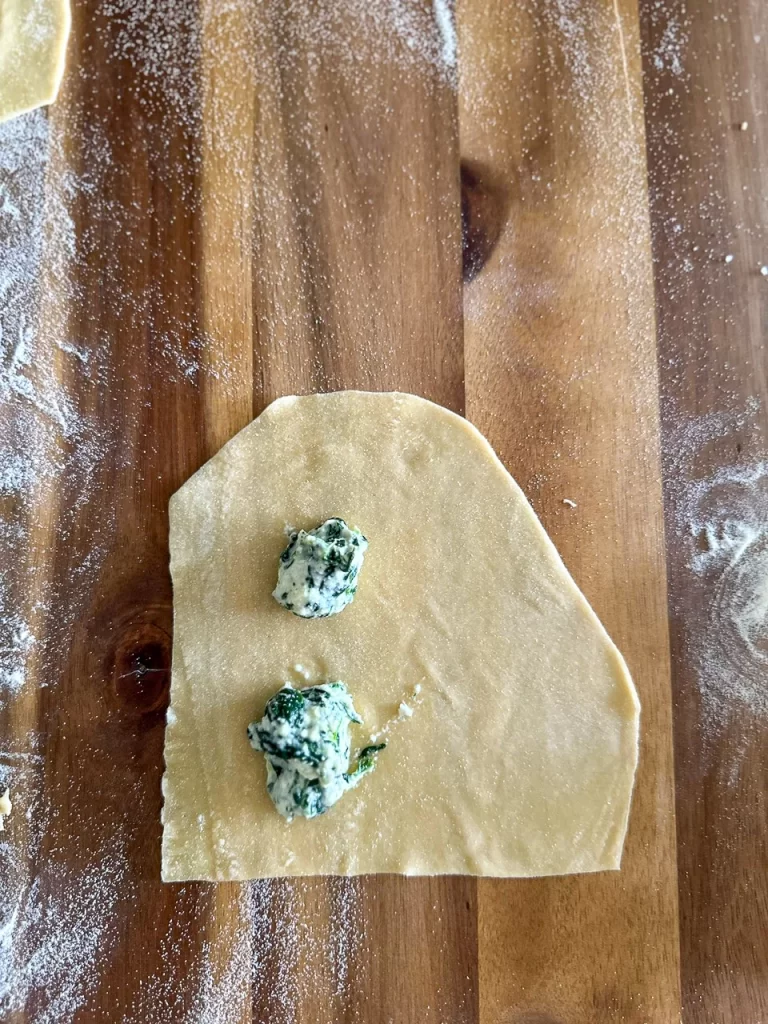
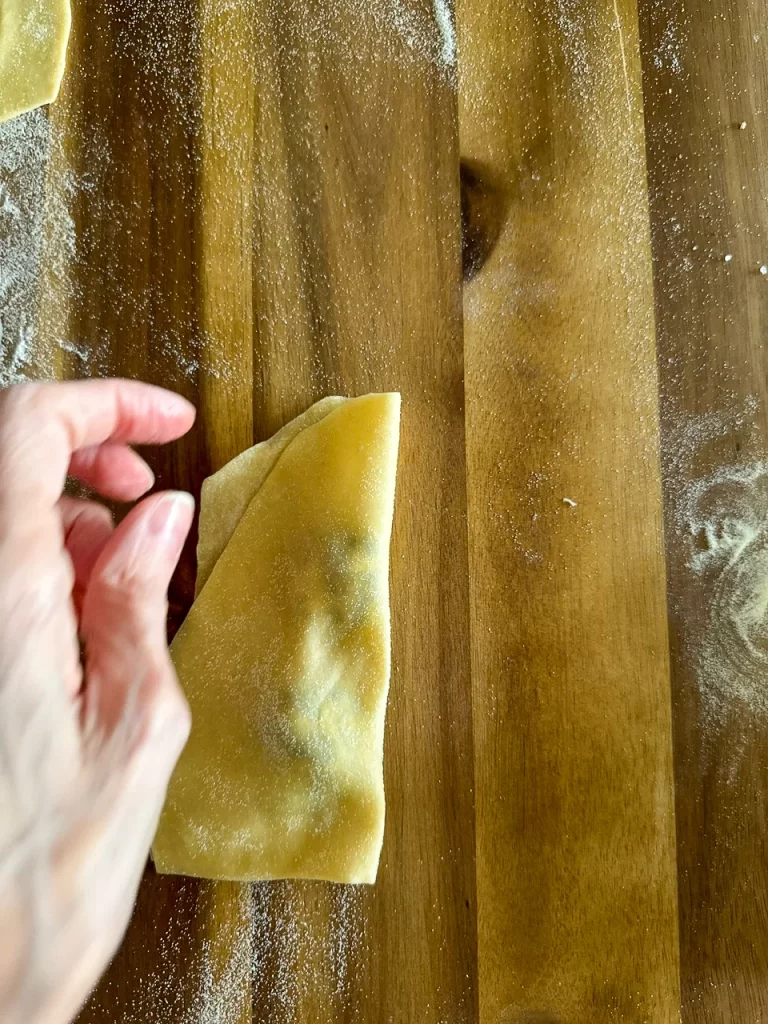
4.Cut into squares using a ravioli cutter or knife, then transfer to a floured tray.
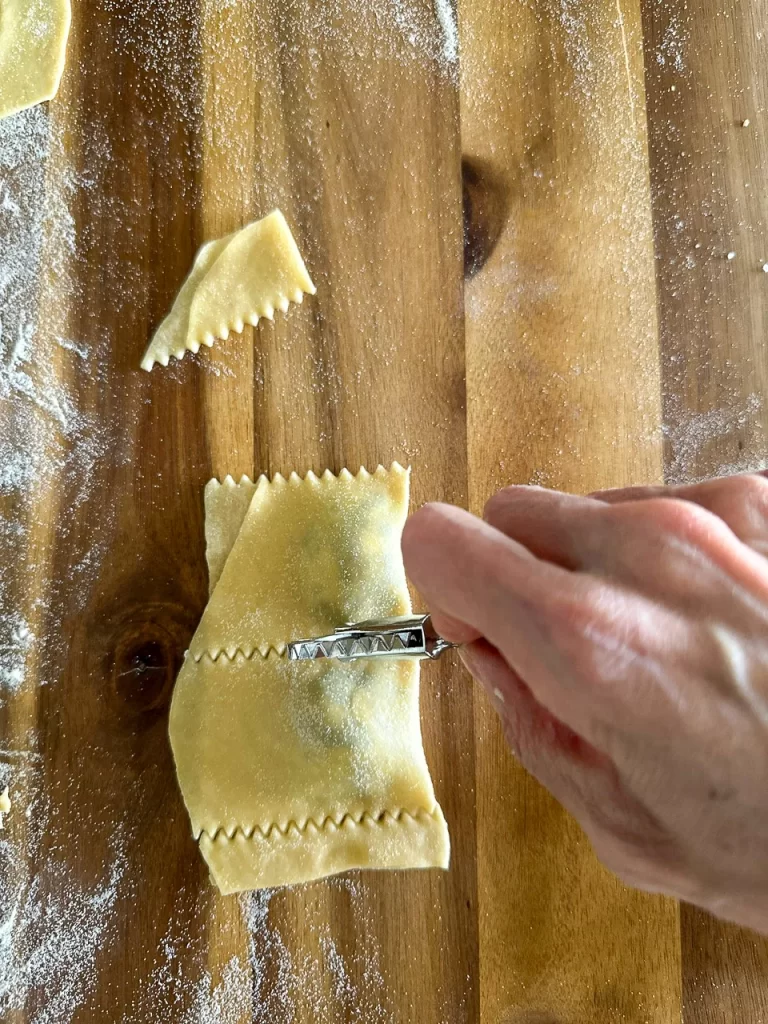
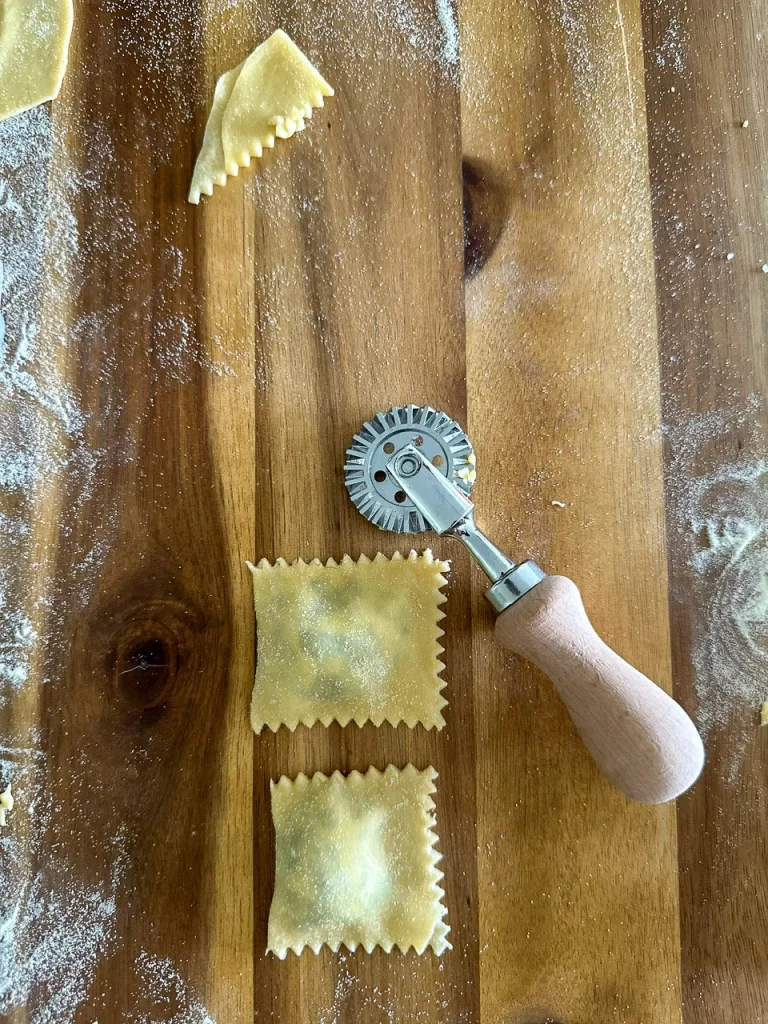
Step 5: Make the Sage Butter Sauce
a) Melt butter in a skillet over medium heat.
b) Add sage leaves and sauté until fragrant.
Step 6: Cook the ravioli
a) Boil a large pot of salted water.
b) Add ravioli in batches and cook until they float (about 3–4 minutes).
c) Remove with a slotted spoon and add them to the serve immediately.
d) Toss the cooked ravioli in the sauce and sprinkle with more Parmigiano Reggiano.
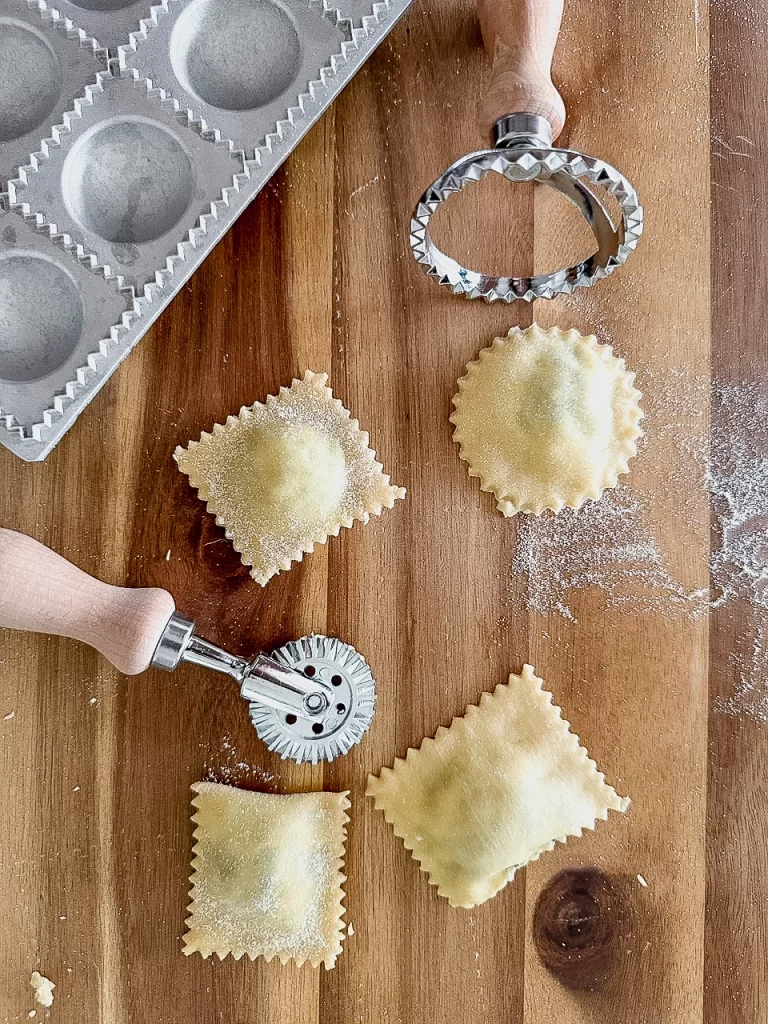
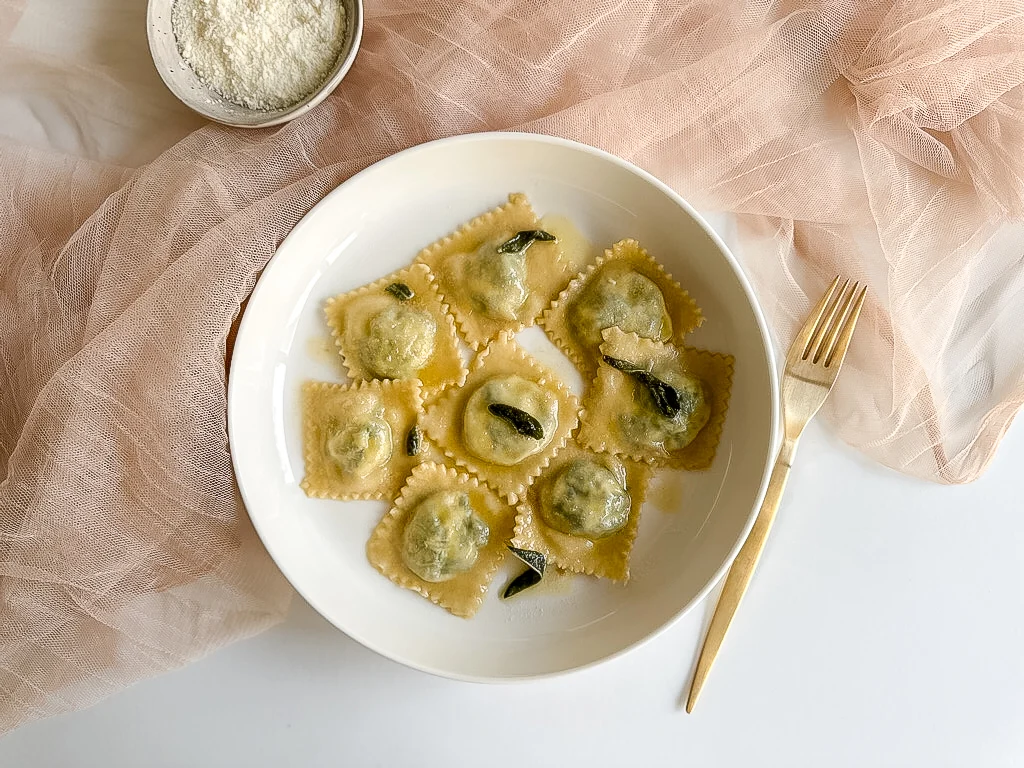
MORE RAVIOLI RECIPES FOR YOU
Beet Ravioli with Goat Cheese and Ricotta


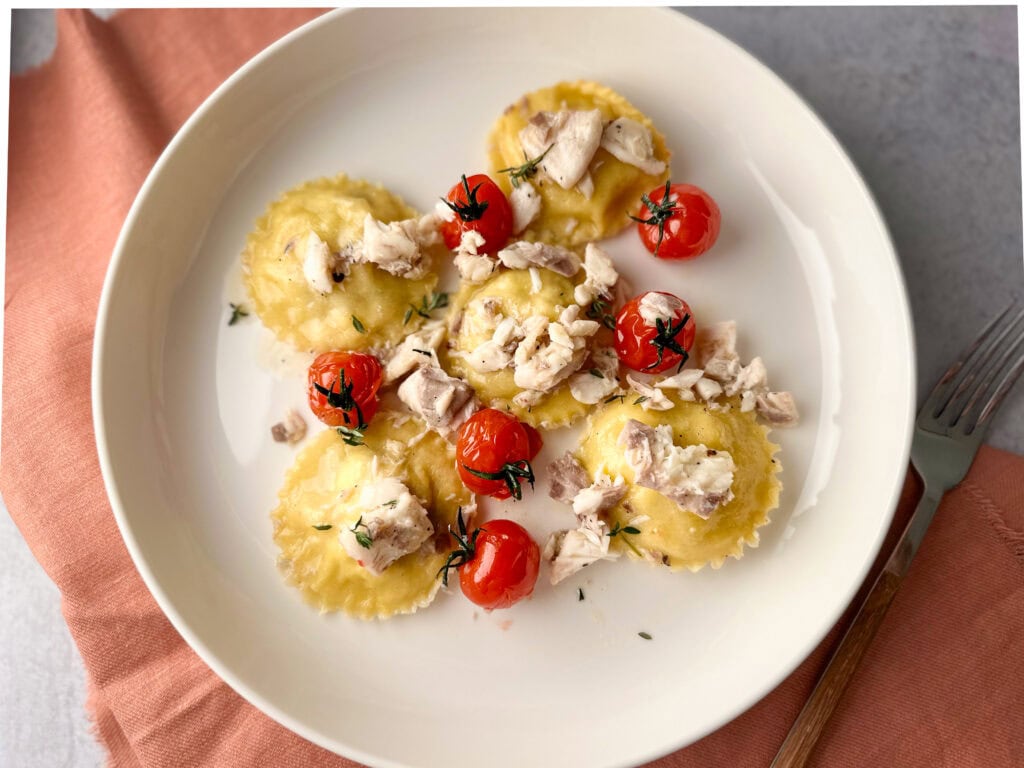
RICOTTA RAVIOLI VARIATIONS
Looking for some twists?
Here are some ravioli filling ideas:
–Cheese: Swap in goat cheese, mascarpone, or a bit of pecorino for a sharper bite.
–Greens: Try kale, Swiss chard, or arugula instead of spinach. In season, you can also try wild ramps!
–No egg pasta dough: Use flour and water only for an egg-free option.
–Vegan ravioli: Use plant-based ricotta and omit the egg yolk.
– Gluten-free: Use a gluten-free flour blend specifically designed for pasta.
If you want to be fancier, add some toppings:
-Crunchy: you can add nuts such as hazelnuts, walnuts or pine-nuts to add an element of crunch.
–Savory: Shaved Parmesan or Pecorino
–Herbaceous: some microgreens or herbs.
In terms of sauce, check my classic sugo al pomodoro (tomato sauce), or a genovese pesto.
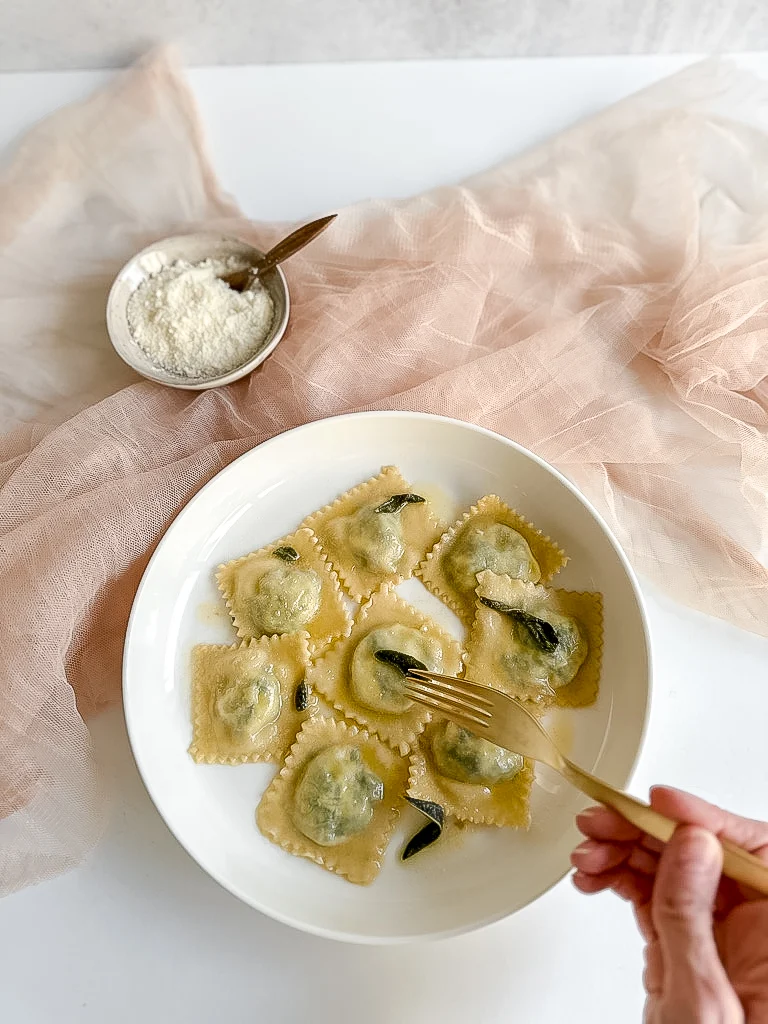
WHAT TO SERVE WITH SPINACH RICOTTA RAVIOLI
Wondering what to serve with homemade ravioli? Keep it simple:
Try my Little Green Italian Salad: arugula, walnuts and shaved Parmigiano Reggiano with lemon vinaigrette. Or also a zucchini carpaccio is great and light.
Some vegetables such as Roasted Bell Peppers or Asparagus.
You can serve some Rustic bread or focaccia.
If you want something more substantial, prepare a classic antipasto platter: always a hit, especially if served as appetizer, family style.
For dessert, I recommend a Strawberry panna cotta or a tiramisu.
HOW TO STORE AND FREEZE HOMEMADE RAVIOLI
You can refrigerate your ravioli, uncooked in a single layer, covered with plastic, in the fridge for up to 1 day.
Cooked ravioli can be kept in an airtight container for up to 2 days.
If you wonder if you can you freeze homemade ravioli, yes you can and should, especially if you have done a bih batch!
Place uncooked ravioli in a single layer on a parchment-lined tray. Freeze for 1–2 hours until solid.Transfer to a freezer bag, label, and freeze for up to 2 months.
To cook frozen ravioli you can boil them directly from frozen. Don’t thaw. Add 1–2 minutes to the usual cook time.

WINE PAIRING FOR SPINACH AND RICOTTA RAVIOLI
What wine pairs well with spinach and ricotta ravioli? With this sauce I recommend
A Vermentino or Gavi—crisp, slightly herbal whites with good acidity, will contrast and complement the creamy ricotta filling and the velvety butter sage sauce.
If you prefer red, go for a chilled Frappato.
You can always serve some Prosecco, especially if you start with an aperitivo.
These Italian wine pairings complement the flavors without overpowering the dish.
FAQ: SPINACH AND RICOTTA RAVIOLI
Can I use frozen spinach?
Yes! Thaw completely and squeeze out as much moisture as possible.
How long to boil fresh ravioli?
Boil them 3–4 minutes in gently boiling salted water until they float.
Why is my ravioli dough too dry or cracking?
Add a teaspoon of water and knead until smooth. Let it rest to relax the gluten.
How do I seal ravioli without a mold?
Use water to moisten the edges and press firmly around the filling. A fork can help crimp the edges.
Can I make ravioli ahead of time?
Yes—freeze them uncooked or refrigerate for a few hours before cooking.
Can I make ravioli without a pasta machine?
Yes you can, you will need to use the rolling pin and a lot of muscles!
How to seal ravioli without a mold?
You will need to add some water around the filling to seal better your ravioli, in addition ensure you remove all air, pressing gently all the sides. This will prevent the ravioli to break during boiling.
I hope you liked this homemade Ravioli recipe! If you try this recipe and you liked it, please leave a star review below! I would be very appreciative of your comments! Make sure to tag me on Instagram @Italian_kitchen_confessions I hope you loved it! To get more ideas follow me on Pinterest.
Ingredients
For the egg pasta dough
- 265 gr flour 00
- 1 tsbp semolina
- 3 whole eggs
For the ravioli filling
- 70 gr spinach
- 2 tbsp Parmigiano
- 120 gr ricotta whole
- 1 tsp nutmeg freshly ground
- 1 tsp salt
- 1 tsp pepper black, crushed
For the Ravioli Sauce
- 50 gr butter
- 1 sprig sage fresh
- 4 tbsp Parmesan
Instructions
Step 1: Make Fresh Pasta dough for Ravioli
- Form a Well:On a clean work surface, pile the flour into a mound and create a wheel l in the center. Crack the eggs into the well and add a pinch of salt.
- Mix:Whisk the eggs with a fork. Incorporate the flour from the edges of the wheel and incorporate it as you whisk.
- Knead:Use a bench scraper with cutting movements until all flour has been incorporated. Gather the dough together with your hands and start kneading. Knead firmly for about 8–10 minutes, until the dough becomes smooth and elastic.
- Rest:Cover the dough in a plastic wrap, place it in the refrigerator for 30 minutes. Alternatively you can cover it with a tea towel or an upside down bowl and live it at room temperature, away from any source of heat or cold air.
Step 2: Make the Ricotta and Spinach Filling
- You will need to boil them 2-3 minutes in boiling water. Strain them with a spider, and place them in water and ice for them to keep the green color and get cold. Once cold, squeeze them very well and remove all the water.
- Chop finely and mix with ricotta, Parmigiano, egg yolk, nutmeg, salt, and pepper.
- Stir until smooth and refrigerate while you roll out the dough.
Step 3: Roll the dough into fresh pasta sheets
- After you rested the dough for 30 minutes, divide it into 4 parts and cover them with a linen towel to prevent your dough to dry. With a rolling pin well-floured, start by rolling each piece from the center to the outer part on a floured countertop. When it reaches around 1/8 inch of thickness, the you are ready to use a pasta machine.
- Use a pasta machine: and pass the dough through its rollers. I use the thickness of 0 at first, then I pass it to more times into thinner thickness. I usually proceed from 0 to 2, then 3, then 4 and then 6. By doing this, you will obtain the lasagna, which is a wide stripe of pasta.
- Cut the sheets: At this point you need to cut your sheets into the desired shapes of pasta. Let’s learn how to make ravioli shape!
Step 4: Shape and Fill the Ravioli
- Lightly flour your ravioli mold. Shake the excess of flour. of Place one sheet of pasta on top of the ravioli mold, ensuring to fill each hole.
- With a pastry bag, add a mounds of filling in each hole.
- Place on top another sheet of pasta to close the ravioli. Using a rolling pin, press and roll to cut the excess of pasta.
- Flip over your ravioli mold, and you have your ravioli.
Step 5: Make the Sage Butter Sauce
- Melt butter in a skillet over medium heat. Once dissolved, add sage leaves and sauté until fragrant.
Step 6: Cook the ravioli
- Boil a large pot of salted water.
- Add ravioli in batches and cook until they float (about 3–4 minutes).
- Remove with a slotted spoon and add them to the serve immediately.
- Toss the cooked ravioli in the sauce and sprinkle with more Parmigiano Reggiano.